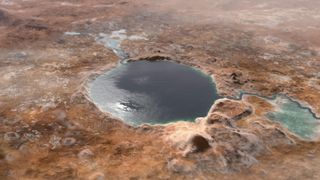Is there life on Mars? A NASA scientist explains in new video
Could life have once existed on Mars, or could it still prosper there to this day?
The search for life beyond Earth is a core motivation of many missions to explore the Red Planet and in this new video, a NASA scientist takes a close look at the question driving it all: Is there life on Mars?
NASA has a number of missions in operation at the surface of Mars that are intensely engaged in the search for traces of life. Primary among these missions are the rovers Curiosity, which landed on Mars in 2012, and Perseverance which set down on the Martian surface in 2021. The latter of these has been collecting cores from rocks from the Jezero Crater where minuscule traces of life may have been trapped.
“We're just now getting instruments onto the Martian surface that can help us understand these potentially habitable places and we can ask deeper questions about the potential for habitability in those rock cores," Heather Graham, an astrobiologist at NASA's Goddard Space Flight Center in Greenbelt, Maryland, said in the 1-minute video released on Dec. 28. "We've been looking for life on Mars for a long time."
Related: How Mars microbes could survive in the salty puddles of the Red Planet


NASA scientist Heather Graham is an organic geochemist and research associate based at the agency's Goddard Space Flight Center in Greenbelt, Maryland who studies the connections beween biotic and abiotic systems. Her research focuses on "agnostic biosignatures," which NASA describes as evidence of living systems that may not share commonalities with life on Earth.
Graham's research has focused on the development of tools and techniques that can help us identify evidence of living systems that may have biochemistry different than life on Earth, also known as "agnostic biosignatures."
As they investigate Mars and aim to study other solar system planets for traces of life, scientists need detection methods that suppose a common heritage with life on Earth. These methods could also help scientists understand life deep within the Earth where life could be very different than that at the surface of the planet as a result of following different evolutionary lines for billions of years.
"And while NASA hasn't found any evidence of life now, we've found lots of evidence that Mars could have supported life in the past,” Graham explained. "There are lots of pieces of evidence that say there was once a huge ocean on Mars and an atmosphere that could have supported life."
Get the Space.com Newsletter
Breaking space news, the latest updates on rocket launches, skywatching events and more!
One of the most important lines of evidence that suggest Mars could have once supported life is the fact that the now dry and arid planet once harbored an abundance of water, a key ingredient for life.
The fact that the 45-kilometer-wide (28-mile-wide) Jezero Crater was once flooded with water and was home to an ancient river delta is the reason NASA chose it as the landing area for the Perseverance rover.
Around 4 billion years ago the river channels in Jezero spilled over the crater walls creating a lake, also filling it with clay minerals from the surrounding area. If microbial life existed in Jezero during these wetter Martian, times signs of this life could remain in the lakebed or shoreline sediments. Thus, the signs of this past life could exist in samples of Mars rock and soil collected by Perseverance.

On Earth, our magnetic field stops harmful radiation from stripping away the atmosphere and protects life on the planet’s surface. Mars is believed to have lost its water when it lost its magnetic field around 4 billion years ago. Without an atmosphere, there was nothing to prevent Mars’ water from evaporating and then being lost to space. This radiation also made the existence of life at the surface of Mars unfeasible.
Yet, there is a chance that liquid water could still exist beneath the surface of the planet and thus Graham thinks that if life still exists on Mars it would also be beneath the planet's outer layers. The advantage of a subsurface dwelling would be layers of rock and soil providing protection from harmful solar radiation once delivered by the Red Planet’s magnetic field.
"There are places that are potentially habitable, like the deep subsurface. There are places underground that could have fluids in them or organisms could live, and they’d be protected from the radiation that’s so harmful on the surface," Graham explained. "So is there life on Mars? Not that we've found yet, but there's still a lot of Mars left to explore."
Follow us on Twitter @Spacedotcom or on Facebook.
Join our Space Forums to keep talking space on the latest missions, night sky and more! And if you have a news tip, correction or comment, let us know at: community@space.com.

Robert Lea is a science journalist in the U.K. whose articles have been published in Physics World, New Scientist, Astronomy Magazine, All About Space, Newsweek and ZME Science. He also writes about science communication for Elsevier and the European Journal of Physics. Rob holds a bachelor of science degree in physics and astronomy from the U.K.’s Open University. Follow him on Twitter @sciencef1rst.











